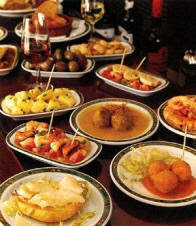 It's easy to see why these spiced buns mark the start of Easter. Religious symbolism aside, their light texture and gentle sweetness make for a perfect spring breakfast. Follow Our step-by-step recipe and welcome the morning sunshine into your kitchen. The symbolism of the hot cross bun has fueled much debate over the years. Stories abound: one is that in Tudor times the English church, in a fit of anti-Popish pique, tried to ban them, but in light of their continued popularity, Elizabeth I relented and allowed them to be eaten during religious festivals. Others believe the bun is of pagan origin, its cross representing the four quarters of the moon or a sign to ward off sickness. In recent years, some schools have courted controversy by taking the buns off their menus in an act of political correctness. But despite historical and religious ructions, the scent of spice and sugar wafting from baking buns remains redolent of harmony and abundance, the mixture of fruit and peel in the dough adding a little luxury.I thought we'd give you some hot tips on how to make great Hot Cross Buns - plus throw in a recipe for you.
It's easy to see why these spiced buns mark the start of Easter. Religious symbolism aside, their light texture and gentle sweetness make for a perfect spring breakfast. Follow Our step-by-step recipe and welcome the morning sunshine into your kitchen. The symbolism of the hot cross bun has fueled much debate over the years. Stories abound: one is that in Tudor times the English church, in a fit of anti-Popish pique, tried to ban them, but in light of their continued popularity, Elizabeth I relented and allowed them to be eaten during religious festivals. Others believe the bun is of pagan origin, its cross representing the four quarters of the moon or a sign to ward off sickness. In recent years, some schools have courted controversy by taking the buns off their menus in an act of political correctness. But despite historical and religious ructions, the scent of spice and sugar wafting from baking buns remains redolent of harmony and abundance, the mixture of fruit and peel in the dough adding a little luxury.I thought we'd give you some hot tips on how to make great Hot Cross Buns - plus throw in a recipe for you.
Throughout the whole bun making process, try to keep everything warm.
1) Preparing yeast liquid The liquid for reactivating yeast should be "warm", "tepid", or at "blood heat". Approximately 37 C. The correct temperature can be achieved by pouring cold water or milk and boiling water into a measuring jug in equal quantities.
2) Measuring dry ingredients and mixing In cold weather use a warm bowl. Measure all dry ingredients into the bowl. Cut or rub in butter .
If desired melt butter or use oil, add with yeast liquid. When mixing, the consistency of dough should not be sticky. An easy guide - turn dough out onto a lightly floured bench, knead 2-3 minutes. If it sticks to your fingers and bench, give a light dusting of flour. If dough is too dry a little warm liquid could be kneaded in. If dough is too stiff it will be difficult to knead, slow to rise and produce hard, dry buns. If dough is too sticky, buns will not hold their shape while cooking.
3) Kneading In cold weather, pour boiling water on your bench, dry well, with flour, before tipping out dough. Kneading is the alternate stretching and folding of the dough which strengthens the gluten - elastic like protein particles in the flour which makes the dough springy so it is able to stretch to surround the bubbles of carbon dioxide produced by the yeast. The kneading process takes about 10 minutes. The dough should feel smooth, springy, elastic and have a "satin" look about it.
4) First rising in bowl Put dough back into a lightly greased bowl, turn over once to grease top. Cover loosely. Put in a warm place. Avoid dry or direct heat. Allow dough to double in size. The time it takes is not important as it will vary according to temperature. From 1-2 hours or in winter up to 3 hours. Dough should have a round, plump appearance. If sufficiently risen, the imprint of fingertips will remain on top of dough.
5) Shaping dough Knead dough for 1-2 minutes. Shape into buns 4 cups flour will produce 16 - 75g buns. Place buns on a lightly greased, warm oven tray.
6) Proving Yeast is a fungus type of mico-organism which grow best in a warm, humid environment. Allow buns to double in size before cooking. In a warm place it should only take about 30-40 minutes, but it could take up to 1 hour. If under-proved, they will be small and hard.
Moist, warm places for proving:
The Oven: preheat on lowest temperature. Turn off. Sit bowl or tray on a rack over a pan of boiling water. Shut oven door and don't peak for at least an hour. Electric frypan: pour in a little boiling water, add lemon juice to prevent pan discolouring. Set to lowest heat. Sit bowl or tray on a cake rack over water. Place on lid, close vent.
Hot water cupboard: tends to be too dry for buns - a skin forms which inhibits proving. Ideal for bread if the tin is enclosed in a large plastic bag or cover loosely with plastic wrap.
7) Cooking Buns should be cooked in a very hot oven. Melted butter and sweet glazes are applied when cooked.
A point to remember: yeast is alive - feed and keep it warm but most importantly don't rush it and it will reward you well. Happy cooking.
16 PERFECT STICKY HOT CROSS BUNS
1/2 cup milk
1/2 cup boiling water
1 teaspoon muscavado or brown sugar
1 level tablespoon yeast
4 cups white flour
2 tablespoons muscavado or brown sugar - extra
1/4 teaspoon salt
1 tablespoon butter
1 cup mixed fruit
1 tablespoon mixed spice
1 egg - lightly beaten
Pour milk and water into a bowl. Stir in sugar, sprinkle over yeast. Set aside for approx. 5 minutes or until yeast mixture is nice and frothy. Using a larger bowl, mix together flours, extra sugar and salt. Rub in butter, add fruit and spice. Make a well in the center, pour in yeast liquid plus egg, mix thoroughly, dough should be slightly sticky - a little more warm liquid may need to be added. It could be up to an extra 1/4 cup. Turn onto a lightly floured bench Knead for 10 minutes. Return dough to a warm, greased bowl, leave in a warm place to double in bulk. Approx. 1 hour. Punch dough down, turn onto a lightly floured bench, knead 2-3 minutes. To shape buns: Divide dough into 16 pieces. Shape into balls. Place onto a lightly greased tray, one finger width apart. Return to a warm place to double in bulk. Approx. 1 hour. At this stage carefully place on crosses. Bake at 220degC for 8-10 minutes. Brush hot buns with glaze. Deliciously Sticky !!
Sticky glaze: Mix 2 tablespoons muscavado or brown sugar, 1/2 teaspoon cinnamon with 1/4 cup boiling water. To create a syrup, microwave for 2-3 minutes.
Crosses: Rub 1 tablespoon chilled butter into 1/4 cup flour then mix to a soft dough, using 2 tablespoons cold water. Divide into 6 portions then roll each into a long string the thickness of your cross. Cut into appropriate lengths and place carefully onto risen buns just before they go into the oven.



























